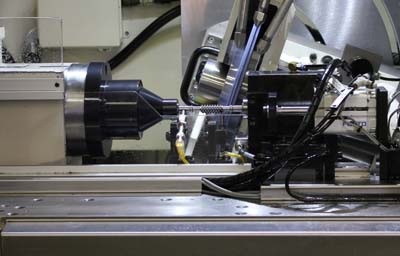
Drake Manufacturing Services Co. has introduced the GS:TE-LM 200 Linear Motor External Thread Grinding System. Although it can be tooled to produce a dual lead worm, the machine can also grind a range of precision threads, ball screws, steering components, gages and complex thread forms.
The machine can be equipped with a robot load pallet system with automatic changeover. The robot picks a part off the pallet and places it in the chuck. A probe detects the part and the wheel is positioned to grind the correct amount of stock from both sides of the worm.
Temperature-controlled machine components including linear motors, motorized rotary dresser and motorized 12kW grinding spindle provide process stability. The machine is also equipped with an in-spindle automatic balancer for longer spindle life and improved surface quality. Workhead index accuracy is less than 10 arc seconds.
Available on all Drake grinders, the GS:TE-LM 200 is equipped with Drake's SmartForm technology. Dressing software is available for true ZA, ZN, ZK and ZI worms, 60 degrees, Whitworth, ISO, Acme, Buttress, full radius, Gothic arch, and other thread forms. Customers can also upload their own thread forms using .dxf files.
The Fanuc CNC system stores grind, dress and load parameters for 120 parts. Operators simply load part parameter information into the Drake PartSmart menus, and the software does the rest. No programming experience is required.
Contact Details
Related Glossary Terms
- chuck
chuck
Workholding device that affixes to a mill, lathe or drill-press spindle. It holds a tool or workpiece by one end, allowing it to be rotated. May also be fitted to the machine table to hold a workpiece. Two or more adjustable jaws actually hold the tool or part. May be actuated manually, pneumatically, hydraulically or electrically. See collet.
- computer numerical control ( CNC)
computer numerical control ( CNC)
Microprocessor-based controller dedicated to a machine tool that permits the creation or modification of parts. Programmed numerical control activates the machine’s servos and spindle drives and controls the various machining operations. See DNC, direct numerical control; NC, numerical control.
- dressing
dressing
Removal of undesirable materials from “loaded” grinding wheels using a single- or multi-point diamond or other tool. The process also exposes unused, sharp abrasive points. See loading; truing.
- grinding
grinding
Machining operation in which material is removed from the workpiece by a powered abrasive wheel, stone, belt, paste, sheet, compound, slurry, etc. Takes various forms: surface grinding (creates flat and/or squared surfaces); cylindrical grinding (for external cylindrical and tapered shapes, fillets, undercuts, etc.); centerless grinding; chamfering; thread and form grinding; tool and cutter grinding; offhand grinding; lapping and polishing (grinding with extremely fine grits to create ultrasmooth surfaces); honing; and disc grinding.
- linear motor
linear motor
Functionally the same as a rotary motor in a machine tool, a linear motor can be thought of as a standard permanent-magnet, rotary-style motor slit axially to the center and then peeled back and laid flat. The major advantage of using a linear motor to drive the axis motion is that it eliminates the inefficiency and mechanical variance caused by the ballscrew assembly system used in most CNC machines.








